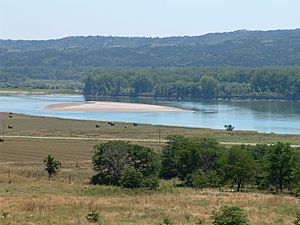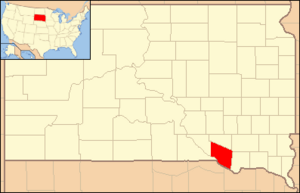Yankton Indian Reservation facts for kids
Quick facts for kids
Yankton Indian Reservation
|
|
|---|---|

Looking toward Sunshine Bottom
|
|

Location of the Yankton Indian Reservation
|
|
| Tribe | Yankton Sioux |
| Country | United States |
| State | South Dakota |
| County | Charles Mix |
| Headquarters | Wagner |
| Area | |
| • Total | 1,772.60 km2 (684.406 sq mi) |
| Website | Yankton Sioux Tribe |
The Yankton Indian Reservation is the special homeland of the Yankton Sioux Tribe. This tribe is part of the larger Dakota nation. It is a place where the Yankton Sioux people live and keep their traditions alive.
This reservation is located in southeastern South Dakota, United States. It covers the eastern part of Charles Mix County. The beautiful Missouri River forms its southwest border. The reservation has a land area of about 665 square miles. In 2010, about 6,465 people lived here. It is one of the largest reservations fully within a single county.
The biggest town on the reservation is Wagner. This is where the tribal government has its main offices. The famous blues-rock band Indigenous comes from Wagner. Also, Zitkala-Sa, a well-known author and activist from the early 1900s, was from this community.
Contents
About the Yankton Sioux Tribe
The Yankton Sioux Tribe is also known as the Ihanktonwan. They are a branch of the Dakota people. Their reservation is located in Charles Mix County. The tribal headquarters are in Wagner, South Dakota.
Land and Language
The reservation covers about 438,100 acres in total. Most of this is land, with some water areas too. The traditional language of the Yankton Sioux is Nakota or Dakota. This language helps connect them to their ancestors.
Who Lives Here?
In 2010, about 6,465 tribal members lived on the reservation. These numbers show the strong community that thrives here. Many people work for the tribe or related services.
Major Employers on the Reservation
Several places provide jobs for the community. The Fort Randall Casino is a big employer. The Indian Health Service helps keep people healthy. The tribal office and the Bureau of Indian Affairs also employ many. Marty Indian School is another important employer.
How the Tribe is Governed
The Yankton Sioux Tribe has its own government. They hold elections to choose their leaders. These leaders make important decisions for the community.
Elections for Tribal Leaders
Elections happen every two years. A primary election is held in July. The main election is on the first Thursday in September. The main leaders are elected by all tribal members. They serve for two years. The reservation is divided into 5 election districts.
Tribal Meetings
Regular business meetings are held once a week, usually on Tuesday. These meetings help the leaders manage daily tribal affairs. There is also a big annual meeting called the General Council Meeting. This meeting happens on the third Tuesday in August each year. For a meeting to be official, at least 5 members must be present.
Important Yankton Sioux Leaders
The Yankton Sioux people have had many strong and wise leaders. These leaders helped guide their people through many changes.
Chief Struck by the Ree (1804–1888)
Chief Struck by the Ree was a very important leader. He was known for being friendly with white settlers. At the same time, he stayed completely loyal to his own people. He worked hard to protect their interests. Chief Struck by the Ree passed away in 1888 in Greenwood.
Chief Running Bull (1826–1900)
Chief Running Bull, also known as Tatankaiyanka, became chief after Struck by the Ree. He signed the Treaty of 1858. This treaty was an agreement between the tribe and the U.S. government. Running Bull's father, Zuyesa, also signed an earlier treaty in 1837. That treaty gave tribal lands east of the Mississippi River to the U.S.
Education on the Reservation
Education is very important to the Yankton Sioux Tribe. They have schools that help children learn and grow.
Marty Indian School
Marty Indian School is located in Marty. This school is connected with the Bureau of Indian Education (BIE). It provides education for children living on the reservation.
Communities on the Reservation
Several towns and communities are located within the Yankton Indian Reservation. These places are home to tribal members and others.

